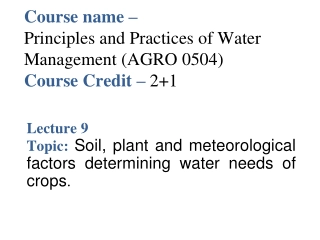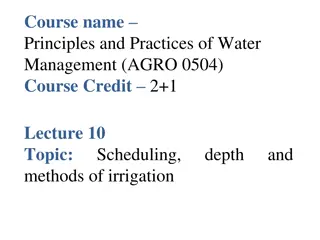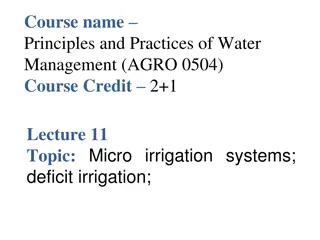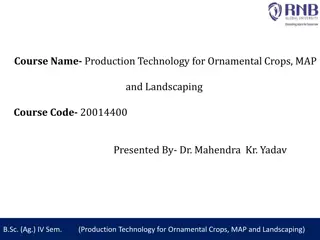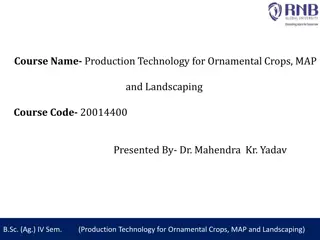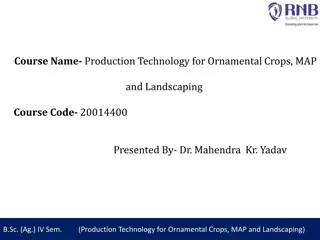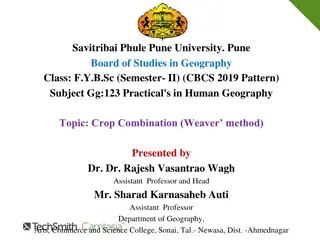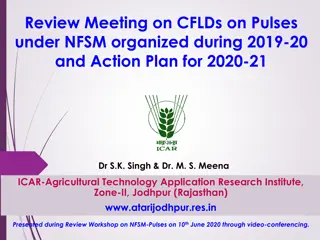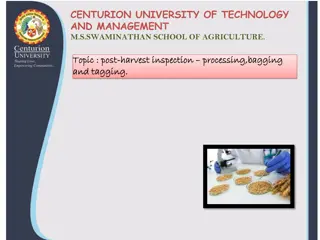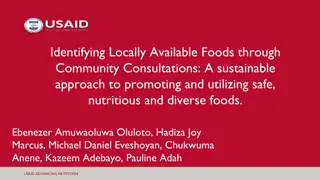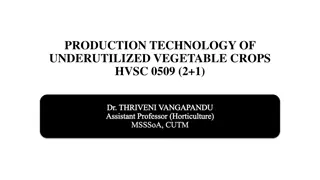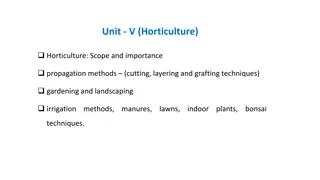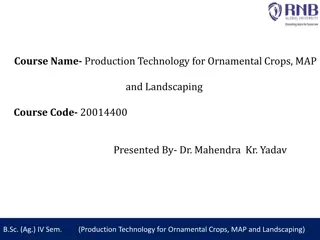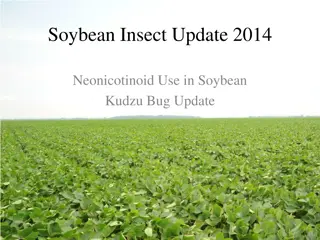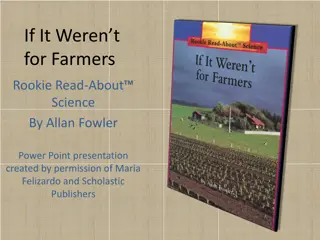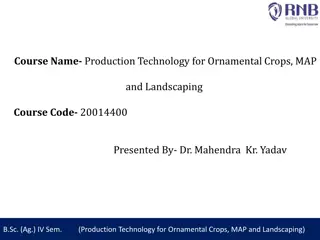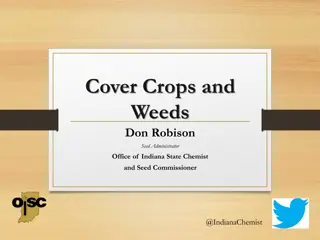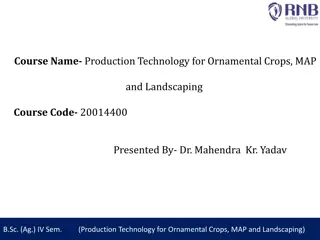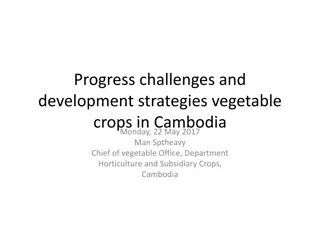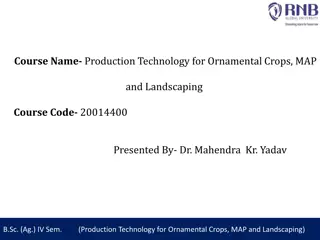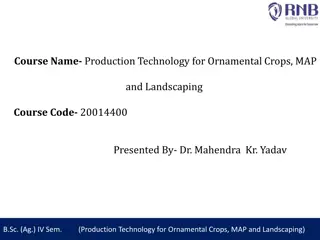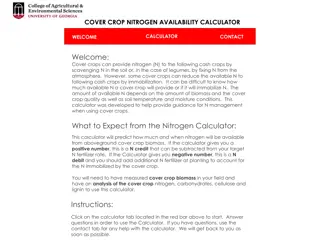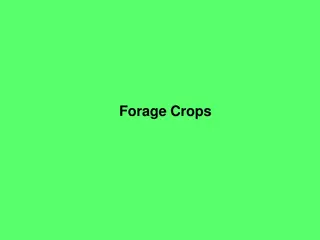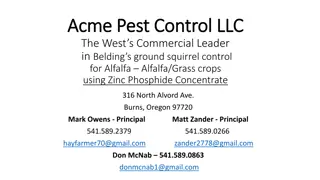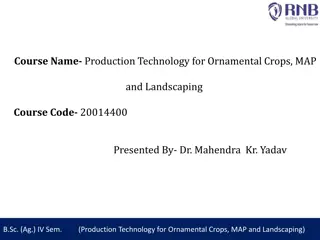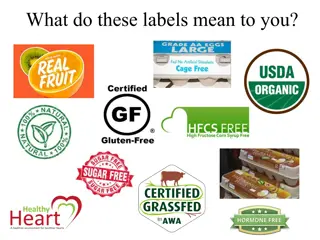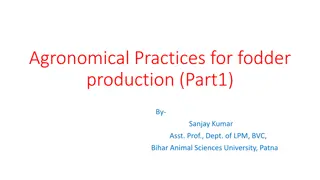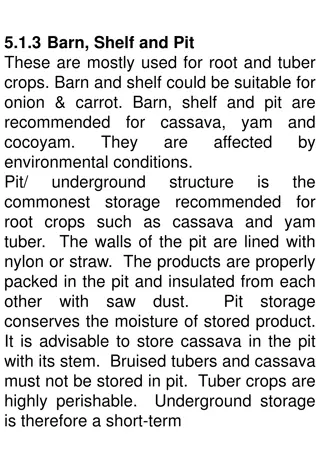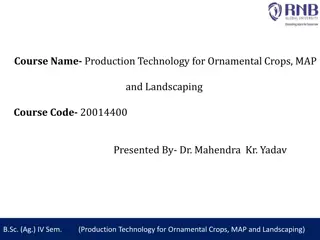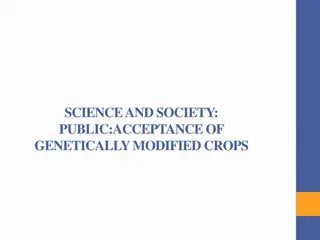Understanding Water Needs of Crops Based on Soil, Plant, and Climate Factors
How soil, plant, and meteorological elements impact water requirements of crops. Dive into the effects of temperature, solar radiation, pressure, wind, and humidity on crop production and growth.
2 views • 19 slides
Production Technology of Underutilized Vegetable Crops: Kale and Collards Overview
Explore the production technology and characteristics of underutilized vegetable crops Kale and Collards, including their origins, types, and growth habits. Learn about their nutritional value, cultivation, and unique features that make them ideal additions to kitchen gardens.
0 views • 13 slides
Understanding Irrigation Scheduling for Optimal Crop Yield
Scientific irrigation scheduling plays a vital role in determining the correct timing and quantity of water application for crops to enhance yields efficiently while preserving soil quality. Various criteria are utilized in irrigation scheduling, such as potential evapotranspiration (PET) estimation
13 views • 58 slides
Principles and Practices of Micro Irrigation Systems
Explore the world of drip irrigation, a precise and efficient method of watering crops. Originating in Israel in 1964, drip irrigation is widely adopted in regions with water scarcity and salt issues. This system enables controlled water application to a variety of crops, increasing yield and conser
4 views • 23 slides
Understanding Hydroponics: Methods, Advantages, and Crops
Hydroponics, derived from Greek words meaning "working water," is a soilless plant-growing method. It offers various advantages like efficient water use, pesticide-free produce, and higher yields. Different types of hydroponic systems exist, enabling the cultivation of a wide range of crops. However
1 views • 15 slides
Production Technology for Ornamental Crops and Landscaping: Ashwagandha Cultivation and Benefits
This course covers the production technology for ornamental crops, medicinal and aromatic plants, and landscaping practices. It emphasizes identifying different types of crops, landscaping principles, and the importance of processing and value addition in ornamental crops. Specifically, it explores
0 views • 11 slides
Production Technology for Ornamental Crops and Landscaping Course Overview
This course provides a comprehensive study on the production technology for ornamental crops, medicinal plants, and landscaping practices. Topics include identification of different crops, landscaping principles, package of practices for flowers, processing techniques, and more. Students will learn
2 views • 14 slides
Production Technology for Ornamental Crops and Landscaping Overview
Explore the world of ornamental crops, medicinal plants, and landscaping with Dr. Mahendra Kr. Yadav's Production Technology course. Learn about different crop types, landscaping principles, flower production practices, and the importance of value addition. Delve into ornamental horticulture, floric
0 views • 15 slides
Understanding Horticulture: Cultivation for Food, Beauty, and More
Horticulture involves the cultivation of plants for food, beauty, and various purposes such as decoration and landscape design. It includes the growth of flowers, fruits, vegetables, and ornamental plants, as well as services like plant conservation and landscape restoration. Unlike agriculture, hor
0 views • 10 slides
Understanding Crop Combination in Agriculture
Crop combination is the practice of growing different types of crops together to enhance productivity, soil fertility, and nutrient enrichment while promoting sustainable farming. This method, popularized by John C. Weaver, analyzes the distribution of various crops in a region to optimize agricultu
1 views • 16 slides
Review Meeting on CFLDs on Pulses under NFSM - Summary and Action Plan
A review meeting on CFLDs on pulses under NFSM was organized in 2019-20, with an action plan for 2020-21 presented by Dr. S.K. Singh & Dr. M. S. Meena from ICAR-ATARI, Jodhpur. Major initiatives by KVKs include targeted technological packages, farmer involvement, and participatory planning. The targ
0 views • 7 slides
Seed Post-Harvest Inspection and Processing Guidelines
The post-harvest inspection and processing of seed crops involve various crucial steps from pre-cleaning to seed treatment, bagging, and storage. Following specific prerequisites ensures the quality of the final seed lot. Inspection during processing and seed sorting in different crops is essential
1 views • 8 slides
Promoting Sustainable Local Foods for Nutrition Security in Nigeria
Food and nutrition insecurity in Nigeria is a pressing issue, prompting efforts to identify and promote locally available, nutritious foods. Stakeholder consultations in Sokoto, Kebbi, and Bauchi States highlighted the importance of staple crops like rice and millet, as well as bio-fortified crops.
0 views • 7 slides
Ancient Egyptian Agriculture: Farmers and Floods in the Nile Valley
Agriculture in ancient Egypt revolved around farming, with the majority of people engaged in cultivating crops for subsistence. The fertile Nile floodplain allowed for a productive growing season, primarily focused on wheat, fruits, and vegetables. Farmers faced challenges during the annual flooding
0 views • 8 slides
Production Technology of Underutilized Vegetable Crops HVSC 0509 & Sweet Baby Corn
This informative piece discusses the production technology of underutilized vegetable crops and the cultivation practices of sweet baby corn. It covers aspects such as the origin of baby corn, its nutritive value, different types of corn, major cultivars in India, and more. The content highlights th
4 views • 12 slides
Algorithm for Tree Crops CO2 Removal Potential
Algorithm for the Calculation of Tree Crops CO2 Removal Potential (LIFE14.CCM/GR/000635) focuses on efficiently determining the capacity of tree crops to remove CO2 from the atmosphere. This algorithm considers various factors such as the biological cycle of the tree, cultivation practices, and carb
1 views • 17 slides
Understanding Horticulture: Scope, Importance, and Propagation Methods
Horticulture, a crucial branch of agriculture, focuses on garden crops, intensively cultivated plants for food, medicine, and aesthetics. Discover the scope and significance of horticulture in improving land productivity, generating employment, boosting economic conditions, and providing nutritional
0 views • 26 slides
Principles of Landscape Gardening and Landscaping Techniques
This course on production technology for ornamental crops, MAP, and landscaping covers the identification of ornamental and medicinal crops, principles of landscaping, uses of landscape trees, shrubs, and climbers, production technology of important ornamental crops, and more. It emphasizes the impo
0 views • 14 slides
Neonicotinoids in Field Crops: Update on Soybean Insect Control
Explore the use of neonicotinoids in soybean crops to control pests like aphids and beetles. Learn about their mode of action, concerns regarding environmental persistence, and effects on bee behavior. Discover the current status of neonicotinoid use in field crops and its implications.
0 views • 33 slides
The Importance of Farmers in Our Food Supply Chain
Farmers play a crucial role in our food production, providing us with fruits, vegetables, dairy products, meat, eggs, grains, and more. They work tirelessly to grow crops, raise animals, and ensure a stable food supply for all. Different crops thrive in varying climates, from citrus fruits in warm r
1 views • 26 slides
Production Technology for Ornamental Crops, MAP, and Landscaping: Cinnamomum Production
This course covers various aspects of ornamental and medicinal crops, landscaping principles, and production technology. It explores the cultivation techniques of important ornamental crops, as well as issues related to medicinal and aromatic plants. Specifically focusing on Cinnamomum, the course d
0 views • 9 slides
Understanding Catch Crops and Kale Cultivation
Catch crops are fast-growing crops cultivated during fallow periods, offering advantages like providing additional winter fodder and preventing nitrogen leaching. Kale, a popular catch crop, has a biennial growth cycle and various varieties with different characteristics. Factors like soil suitabili
0 views • 17 slides
Understanding Cover Crops and Weed Management
This detailed content provides insights into cover crop seed regulations, exceptions, and conditions. It also discusses weed seeds in cover crops, including issues with locally grown rye seed. Learn about the farmer exemption, weed species like rye, and seed sample terminology from an official persp
0 views • 17 slides
Production Technology for Ornamental Crops and Landscaping Course Overview
This course provides an in-depth study of ornamental and medicinal crops, landscaping principles, production technologies, and processing methods. It covers identifying different crop types, packaging practices for flowers, cultivation techniques like protected cultivation of Carnation, and the sign
0 views • 27 slides
Production Technology for Ornamental Crops, MAP, and Landscaping with Dr. Mahendra Kr. Yadav
This course on production technology focuses on identifying various ornamental and medicinal crops, exploring landscaping principles, production technology, package of practices for loose flowers, and problems with medicinal plants. It also highlights the importance of processing and value addition
0 views • 16 slides
Brassica and Brassicaceae Family as Forage Crops: A Comprehensive Guide
Understanding the Brassica and Brassicaceae family as forage crops is essential for maximizing agricultural yields. This article explores the taxonomy, main crops for fodder, and the specific characteristics of colza plants. Colza, both winter and spring varieties, offer high productivity and protei
0 views • 14 slides
Agricultural Progress, Challenges, and Development Strategies for Vegetable Crops in Cambodia
The agricultural sector in Cambodia plays a significant role, with vegetable crops being the third most important source of nutrition after rice, meat, and fish. The country faces challenges in vegetable production and distribution, but strategies are being developed for growth. Fruit crops and othe
0 views • 21 slides
Production Technology for Ornamental Crops, MAP, and Landscaping Course Overview
This course, presented by Dr. Mahendra Kr. Yadav, covers the identification of ornamental and medicinal crops, principles of landscaping, production technology, and value addition in ornamental crops and MAPs. Topics include jasmine cultivation, varieties of J. auriculatum, and more.
0 views • 21 slides
Production Technology for Ornamental Crops, MAP and Landscaping Overview
This course covers the production technology for ornamental crops, MAP, and landscaping, presented by Dr. Mahendra Kr. Yadav. It includes identifying different types of ornamental and medicinal crops, principles of landscaping, uses of landscape trees, shrubs, and climbers, production technology of
0 views • 9 slides
Cover Crop Nitrogen Availability Calculator
Cover crops can impact nitrogen availability for cash crops. This calculator helps estimate nitrogen availability from cover crop biomass, guiding N management decisions. It requires data on cover crop biomass and composition. Positive values suggest a nitrogen credit, while negative values indicate
0 views • 7 slides
Understanding Forage Crops and Their Importance in Agriculture
Forage crops play a crucial role in agriculture, with members mainly from the Fabaceae and Poaceae families. These crops provide essential nutrition for ruminants and are cultivated worldwide. The value of forage crops is significant, comparable to non-forage plants, with varying land use patterns a
0 views • 49 slides
In-Depth Guide to Ground Squirrel Control for Alfalfa and Grass Crops
Acme Pest Control LLC specializes in ground squirrel control for Alfalfa and Grass crops using Zinc Phosphide Concentrate. Learn about their process, safety precautions, and successful track record in controlling Belding's ground squirrels. From preparing bait to handling applications, this comprehe
0 views • 15 slides
Dicamba: An Overview of Federal Perspective
The summary covers various aspects of dicamba including federal perspective, label changes, new uses for dicamba-tolerant crops, incidents of crop damage, and related investigations. It highlights the impact on crops, such as soybeans, tomatoes, watermelon, and more, caused by dicamba applications.
0 views • 13 slides
Production Technology for Ornamental Crops and Landscaping: Marigold Cultivation
Learn about the production technology for ornamental crops, including identifying different types of plants, landscaping principles, and the cultivation practices for marigold flowers. Explore the characteristics of French and African marigold varieties, their botanical names, climatic and soil requ
0 views • 13 slides
Understanding Bioengineered Crops and Labeling Regulations
Explore the world of bioengineered crops, misleading food labels, and the regulatory process behind genetically modified organisms. Learn about GMO crops, deceptive labeling practices, and how the FDA ensures food safety standards. Discover the differences between bioengineered and non-bioengineered
1 views • 11 slides
Agronomical Practices for Fodder Production - Part 1
Forage crops, fodder crops, and the characteristics of fodder crops are discussed in this informative content. It covers the classification of fodder into different types such as non-leguminous fodders, legumes, pasture grasses and legumes, fodder trees and shrubs, root crops, and miscellaneous fodd
0 views • 16 slides
Modern Storage Solutions for Root and Tuber Crops
Explore traditional and modern storage structures suitable for root and tuber crops like cassava and yam. From pits and shelves to improved cribs and warehouses, learn about different storage methods to preserve these perishable crops effectively.
0 views • 4 slides
Production Technology for Ornamental Crops and Landscaping - Course Overview
This course covers the production technology for ornamental crops, MAPs, and landscaping, presented by Dr. Mahendra Kr. Yadav. Learn about identifying different types of ornamental and medicinal crops, principles of landscaping, production techniques for important ornamental crops like orchids, and
0 views • 9 slides
Production Technology for Ornamental Crops and Landscaping - Aloe Vera Cultivation
This course covers the production technology of ornamental crops, landscaping principles, and cultivation methods for Aloe vera plants. It includes identifying different ornamental and medicinal crops, landscaping principles, uses of landscape trees, and production techniques for important ornamenta
0 views • 10 slides
Public Acceptance of Genetically Modified Crops: Concerns, Status, and Trust Issues
The discussion explores the concerns surrounding genetically modified crops, touching on public acceptance, regulatory measures, and the current state of GM crops in world agriculture. Surveys conducted in the USA and UK reveal varying levels of public support, with issues of trust, safety, and ethi
0 views • 32 slides
